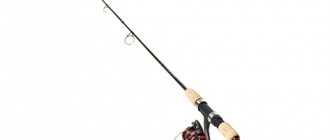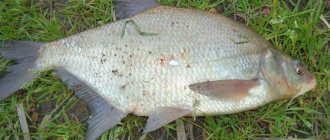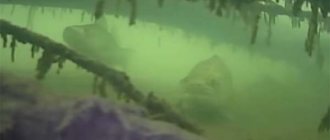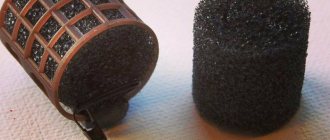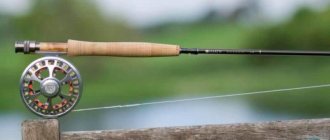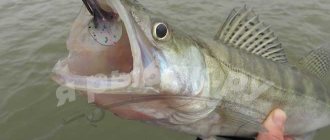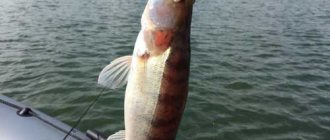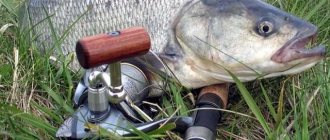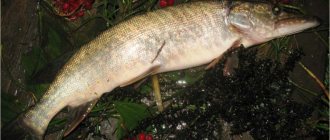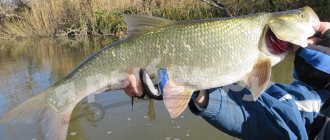Lenok - what kind of fish?
Lenok is a beautiful fish, similar in size and color to river trout. The firmly built body, equipped with small fins, as experts call it “brusok”, looks like a fast-moving torpedo.
Depending on the habitat, the color of the lenok varies from a light silver back (it stays in open water, where it is shallow and light) to dark gray with a lead tint (these prefer mountain rivers, shelters between rocks and rifts). Small scales, thick skin and small sparkles throughout the body complement the similar portrait of all salmon.
Habitat : from Western Siberia to the Primorsky Territory, from the Arctic Circle to Mongolia and North Korea. Lenok prefers running cold water; it can more often be found in the upper reaches of mountain rivers. During spawning, the lenok tries to rise as high as possible, almost to the source, and spawns in shallow water, burying it in small pebbles. It cannot be said that he is very prolific; the eggs are only 50-60 grams.
Juveniles feed on zooplankton and larvae. Gradually, with age, it switches to larger animals: insects, snails, large larvae, even small rodents and birds that have fallen into the water.
Juveniles keep in small flocks, from 5 to 20 individuals. Large fish that have lived for more than 10 years live in pairs or alone. Basically, the age of Lenka does not exceed 15-16 years .
The largest specimens caught reach 0.75-0.9 meters and 8 kg of weight. But on average there are younger individuals 04-0.5 m. up to 3 kg..
Lenok, like all salmon, makes seasonal migrations to breeding grounds, where it spends some time, protecting its offspring from possible danger. He is a caring parent and accompanies the young while they are weak and cannot eat properly. Gradually, parents and offspring descend to their habitual habitats , to spacious river beds that are richer in food.
Where and how to catch lenka in the fall - habitats
The most promising places for catching lenok in the fall are backwaters and places near river rifts. It can also be caught in those parts of the reservoir where there are snags - there it usually hunts for small fish.
The most effective time for catching lenok is from 5 to 8 am, but later there comes a period without biting. Then a good bite can be observed in the afternoon, from about 3 to 8-10 pm. In the fall, lenka can be found throughout the reservoir; this fish, like all others, tries to gain fat before the winter season, so it eats almost everything that it comes across during the hunt.
In open water, lenok can be caught until freeze-up. In summer he is active, preferring places where it is convenient for him to hunt. By autumn, activity decreases, the fish have filled up their reserves for the winter.
Gradually freezing water , depleted of oxygen, forces all fish, including lenka, to flock into small schools and populate “winter apartments”, tanks and pits, where they spend the winter almost in hibernation. Large fish also leave for the winter in pairs.
What to use to catch lenka in the fall? A modern electronic wobbler that imitates the behavior of a wounded fish. Details in the article
What gear to use for catching lenok
Traditionally, spinning and fly fishing are used to catch this large predator. But not everyone knows how to fly fish ; this equipment requires a certain skill and casting accuracy takes a long time to train. But the result when catching fast young fish, of course, is the pleasure of the hunter. Try to hit the target (for example, near a stone, under which, as you are sure, a lenok is sitting in ambush), with a front sight at a distance of several meters, or even a couple of dozen. But you won’t catch much with fly fishing in the fall.
Fly fishing for lenok
At the beginning of autumn, when it is even less warm, it is effective to catch lenok using fly fishing; anglers here use all kinds of worms, insects, flies, both natural and artificial, as bait. For fly fishing using a wet fly, anglers use hooks of 7-8 sizes; if the river is wide enough, then spinning casts are used. In this case, it is better to use light-type spinning rods, but at the same time very durable, because it may happen that the bait is swallowed by taimen, and then it will be very difficult to pull out this fish using fragile spinning rod options.
Catching Lenok with a spinning rod
Spinning is a more traditional equipment. A durable fiberglass or titanium rod, a powerful reel (inertial reel is more reliable) - this is what is needed for catching lenok. The fishing line should be at least 0.4 mm, or better yet even thicker. Hooks (many recommend tees) must be made of durable steel, preferably with hardened tips, which are best sharpened by hand. The strong small jaws of the lenok are difficult to penetrate when hooking. You can use durable metal leashes.
When catching lenok with a spinning rod, it is better to use small bait that will look like a small fish. In this case, baits such as pig, Kola or Geneva, with their sizes of 5.5 centimeters and a thickness of 2.5 millimeters, are very effective for catching lenok.
Features of catching lenok
21.04.2016Lenok is one of the few representatives of the ichthyofauna that prefers to stay in cold mountain rivers with fast currents. Many anglers dream of catching this fish, but to do this they will have to go to the most sparsely populated and undeveloped places in our country.
The most preferred areas for fishing are the rivers of the Far East and Siberia, but to get to them you often have to use a helicopter. Thus, lenka can be found in rivers and lakes, the water of which is distinguished by its purity and low temperature. As for the behavioral characteristics of this fish, medium-sized specimens stick to each other in the form of a flock, but seasoned representatives of the salmon family prefer solitude. The weight of the fish can reach five kilograms and a length of 70 centimeters! But the most acceptable size that our fishermen come across is lenok up to 1 kilogram. This species can be successfully caught using both summer and winter ice fishing gear.
Beyond Lenkom in open water
With the onset of spring, many fishermen go to the rivers in order to catch lenok. It can be caught throughout the open water season, i.e. before freezing begins. For successful fishing, it is recommended to choose your gear wisely. So, for catching lenok there are the following methods:
- Spinning
Classic spinning fishing is a very popular method of fishing in Siberian and Far Eastern reservoirs. Lenok from a young age aggressively attacks any bait, but even here it is necessary to remember some points that will make catching this predator as effective as possible.
— Due to the importance of uniform and calm retrieval of the bait, a spinning rod does not require serious characteristics. If you collect the gear yourself, an old telescopic fishing rod will be suitable for its role, which will successfully withstand the resistance of the lenka when fishing and will allow the angler to get a lot of fishing experiences. As for the length of the rod, it is necessary to take into account local conditions on the reservoir. If you have the opportunity to fish directly at the water’s edge, then a 2.1-2.4 meter spinning rod will be an excellent choice. This length will ensure ease of fishing for lenka from a boat. If there is thick and tall grass growing along the shore, then you will have to look towards the long rod within three meters.
— Spinning rods for lenka fishing are equipped with a spinning reel with a spool rating of 2000-3000. It is also worth paying attention to the presence of a well-tuned friction brake, which will ensure the safety of catching even a solid trophy.
— The fishing line can be either regular monofilament or braided. However, the latter is somewhat inferior to monofilament in terms of its visibility properties in layers of water. Since the standard size of a lenok is up to 1 kg, a 0.2-0.25 mm nylon fishing line is the best combination for catching it.
— When going to the river, you should make sure that you have in your arsenal such baits as rotating and oscillating spoons. When choosing them, you should start from the weight of the bait. Thus, the most preferred spinners for fishing lenka on the river will be castmasters or spinners weighing about 20-30 g. If a shallow or quiet backwater turns out to be a promising place, then it is recommended to use spinners whose length does not exceed 40 mm with tees of 8-10 numbers. The appearance of baits and their color should be selected taking into account local weather conditions, the diet of lenka during the current fishing season, as well as the condition of the reservoir.
- Donka
Many years of fishing practice have made it possible to identify the most effective fishing method, which uses a bottom fishing rod. This gear is one of the local methods of fishing for lenka, since it does not require serious financial costs. The classic old-fashioned “skid”, or donka, is guaranteed to provide the fisherman with a successful day in terms of the number of tails caught.
To make bottom tackle yourself, you need to have the following components:
- A fishing rod made of aluminum or fiberglass, 1.5-2.5 meters long.
- Reel - traditional "Nevskaya" or modern multiplier.
- The diameter of the fishing line is 0.5-0.6 mm, and the length is about 20-30 m.
- To make leashes of the required length of 15-30 cm, monofilament with a thickness of 0.3-0.4 mm is used.
- The selection of weight for equipment should be made based on the strength of the water flow at the future fishing site, as well as the required distance for supplying the bait. The most suitable sinker weight is 40-60 grams.
- The hook for catching lenka should have a number 7-8.
Typically, a fisherman sets several donks at the same time, and an earthworm is used as bait for the lenok. The fish boldly attacks the bait, swallowing it whole, allowing the angler to make a reliable hook in time.
- Catching lenok on the surface of the water
Once local insects such as mayflies or flies are on the wing, you should not miss a great opportunity to fly fish for lenok. Along with it, a tackle called a “boat” is also successfully used. The difference between them is that the latter uses live bait, while in the case of fly fishing, artificial flies are used.
— Having decided to go on a long trip to catch lenok by fly fishing, the fisherman will need not only to purchase reliable and proven equipment, but also to take care of his own comfort. Overalls and waders protect the body not only from water, but also from hypothermia, since you often have to stand in waist-deep water. The presence of a landing net will provide the fly fisherman with convenience when fishing for flax.
- Due to the high cost of fly fishing gear, if desired, a fisherman can make an equally catchy gear with his own hands - a “boat”. Tips for assembling it and drawings can be found on almost any fishing forum.
Winter fishing for lenka
Ice fishing for lenok is in no way inferior to summer fishing. This representative of salmon loves cold water and for this reason, even in winter, it pleases the fisherman with its activity when attacking. So, there are several effective ways to catch lenok from ice.
- Plunge fishing with a spinner
It is immediately worth mentioning the fact that the use of a spoon when catching lenok vertically in winter is fundamentally different from fishing for perch or pike. The difference lies not only in the choice of bait, but also in its game.
— The fishing rod should be 40-50 cm long, on which the simplest reel or classic reel is installed.
— As a fishing line, you should choose a monofilament whose length will exceed the depth of the fishing spot. The thickness of the fishing line with a length of 20-30 m should be 0.3-0.5 mm.
A special feature of the technique of retrieving and playing with bait when fishing for lenok is that the spoon should be kept in the bottom layer. Since the fish stays at depth in winter, it is necessary to create a muddy cloud at the bottom with bait, which will certainly attract the attention of a predator and provoke it to attack the spoon.
- Mormyshka for lenok
The traditional method of ice fishing with a jig is also successful in the case of lenok fishing. A fishing rod for winter fishing often has an individual design that is as convenient as possible for the fisherman. However, there are some basic points that no tackle can do without:
— A plastic rod with a nylon whip up to 15 cm long. The reason for this limitation is that this length is optimal enough to absorb strong jerks of the line during hooking. As for the nod, it is selected based on the parameters of the selected jig.
— The fishing line should be thin enough, since a thick and coarse thread negatively affects the performance of the bait and artificial fly, in particular. It is recommended to choose a fishing line with a diameter of 0.2-0.22 mm.
— The linen hook should not be too small. Preferred number: 6-7. The thick shank of the hook will allow the fisherman to safely fish out even large specimens weighing up to 2.5 kg.
— In addition to using artificial flies, lenok also actively attacks live baits in winter: worms, caddisfly larvae, bark beetles, bormys, burdock moths, etc. The “secret” of a catchy bait is the following technique: you need to tie several thin woolen threads of a bright or contrasting color to the hook with a medium of color. This will attract a predator from afar, and live bait will provoke it to attack.
For most anglers, catching lenok in the rivers of Siberia and the Far East remains an unattainable dream due to the remoteness and inaccessibility of these places. But having been there once, be sure that such a trip will remain in your memory for a lifetime and is really worth spending your time on.
What to catch lenok with - bait
Lenok is best suited for imitating live prey. Of course, he will bite on a feeding worm, but if the bait resembles the prey he is used to and plays with it, the fenok will be much more willing to take the hook.
Therefore, fishermen have come up with a huge number of baits that are attractive to predatory fish. These are flies that imitate insects that the lenok mainly hunts: large flies, dragonflies, caddis flies and mayflies. For some reason, flies are more popular in the fall. Artificial flies are much larger in size than natural flies.
Catching lenok in the fall with a spoon . The game of rotating and oscillating spinners fascinates him equally, so it’s better to take both with you. Depending on the lighting, Lenka's preferences change.
The cloudier the weather , the brighter the spoon should be, polished golden, for example. In sunny weather, fish are more willing to go for a matte bluish-silver toy. So stock up on medium-sized lures; small fish are of little interest to Lenka.
Especially advanced spinning anglers catch lenok using wobblers - and this method has many advantages over other baits:
- the wobbler goes strictly at the depth you set (it always holds the desired horizon well)
- the wobbler, all other things being equal, gains depth much faster;
- Requires lower wiring speed for stable play;
- holds strong currents much better
Modern electronic wobblers can imitate the behavior of fish that are wounded or weakened by disease. They emit three types of signals - light, sound and vibration, thereby greatly provoking a Lencan attack. You can read more about such wobblers here
This article will tell you about Lucky John silicone baits.
In this article you will learn how to properly install silicone baits.
as nutritious bait . You can use worm imitations, called rubber bands. Fishermen have noticed that lenok are more willing to take bright pink ones, similar to the color of wild rosemary.
In different rivers, Lenka's hunting grounds provide him with their prey. So you can try fishing with live bait . For example, a small minnow or sculpin goby can attract large fish.
In Eastern Siberia, the so-called “zakidushka” is popular. This is a primitive tackle. Take a thick fishing line with a large sinker at the end, 15-25 meters long. Two or three leashes with powerful tees are attached to the fishing line; the bait is preferably in the form of flies with a worm on hooks.
Are you interested in catching rotan using a spinning rod in the fall? Our article will tell you and show you more about this.
And here we will talk about fishing for catfish in the autumn.
What else can you use to catch lenka?
You can interest an aggressive predator with an artificial mouse. This is a unique invention of resourceful fishermen. It can be made from wood or foam. The optimal bait size is 10 cm in length, weight 40-75 g. But they are also caught on larger structures with a size of 18 cm and a weight of over 120 grams. Volumetric devices are more suitable for catching trophy taimen. The mice are equipped with sharp treble hooks. It is better to use them in the dark. It is first necessary to study the fishing site. The casting of an improvised rodent is carried out at a distance of 30-40 m from the coastline.
It is necessary to cast such a device in such a way that after landing it creates a splash of water, which is guaranteed to attract the attention of a predator. During the fishing process, the fishing line is gradually tightened and pauses are made so that from the outside it looks as realistic as possible. Considering that artificial mice are mainly caught by trophy specimens, the fishing thread must be of high quality and reliable.
Another option for catching a predator is hunting with an artificial fly. To do this, you will need a fishing tool with a length of up to 5 m, a fishing line with a cross-section of up to 0.25 mm, its length should be 2 m greater than the length of the rod. A pellet is mounted slightly above the hook to improve casting quality. The artificial bait used should look like insects flying along the river bank. The opening of the season in the spring will depend on the time the first insects appear.
The fishing process itself consists of fishing various promising places, where, after casting, the bait is slightly tugged and pulled towards you. The main thing is that it constantly stays in the upper layers of water. After making a series of casts in one area of the reservoir, the fisherman goes downstream to examine other promising areas.
After the arrival of autumn frosts, the flight of insects stops, therefore, catching lenok with artificial bait becomes irrelevant. At this time, the fry works better. A long fishing tool is suitable for such hunting. The bait is attached to a hook, piercing the back behind the head so that the sting comes out through the abdomen.
Features of autumn lenka fishing
The lenok pecks more often in the morning and comes out “for breakfast.” Be prepared to get up at dawn and wander along the shore for a couple of hours. First you need to check the depth of the area where you will go. In autumn, the lenok stays near the bottom , so you need to set the depth as accurately as possible. Often fishermen set the depth so that the bait touches the bottom. To do this, you need heavy weights at the end of the fishing line, rounded so as not to get caught on the bottom.
In Siberia they are called “dumplings”. A large float drags a sinker along the bottom , and the flies “play” on short, 0.4-0.5 meters, leashes not far from the bottom.
When trolling, the bait can be moved and twitched , imitating the throws of a small fish. In this case, you risk missing the bait under the predator’s nose, but if he sees the throw, he will definitely become interested.
The second bite begins after lunch, from 14-15 hours until dusk. The fish are not as active as at dawn, but they are biting. Mainly because the lenok prefers to hunt in the light. He has pretty good eyesight.
Fishing with a hook is very simple. The equipped tackle is cast to the maximum length of the fishing line , on average 15-20 meters. The sinker lies quietly on the bottom, the bait floats near the bottom. A curious fish (including lenok) swallows the bait, and when trying to get off the hook stuck in its jaw, it becomes firmly “anchored.”
The fisherman almost does not need to hook; the lenok itself, out of habit, swallows the prey deeply and will not leave the hook. All that remains is to bring out the fish, which are often already exhausted in the fight. The main thing is that the tackle is of increased strength.
In Siberia, catching lenok with a “mouse” is common. Fishermen make an artificial mouse from some kind of floating material , make it unsinkable using polymer or wax impregnations and line it with fur. Often even natural. But now faux fur is also good. To make the “mouse” as natural as possible, they even glue a mustache and eyes onto it.
And at the back, through a leash passed through the bait, a powerful tee hook is attached. Only a very large predator can bite on such prey.
The fisherman throws the “mouse” into the current and leads it for several tens of meters, twitching it to revive the bait. The fishing method is very effective. It’s not for nothing that he’s been so popular for who knows how long. It was with the “mouse” that 8-kilogram giants were caught.
It is difficult to breed lenka ; it is a very strong and active fish. Powerful throws can break the tackle if there is slack and the predator picks up speed. Therefore, you need to keep the line “tight” all the time, not allowing it to move away for a second, and constantly bring the fish to the shore. Avoid aquatic grass or snags near the shore, he will try to rush into them to tangle the fishing line.
It is this technique of his that often leads to him getting off the hook. But if he finds himself in shallow water , he falls into a state of “exhaustion,” and here he must not yawn. In this short period of time he is helpless. Often, in the heat of battle, a fisherman rushes into the water and throws the fish ashore with his hands. What a fight!
Selecting spinning tackle
Catching lenok with spinning tackle in rivers and lakes can only be successful if you have high-quality fishing tools and equipment. To assemble fishing tackle for a typical predator from the salmon family you will need:
- A rod with a length of 2.5-2.7 m and a test load of 10-30 g, which will allow you to more effectively control the bait, spend less effort around various obstacles (grass, stones) in the fishing area and, most importantly, provides good shock absorption when landing prey ashore, reducing the load on the line and reel. If fishing is carried out from a boat or the coastline is close to the water, then you can use rods with a length of 2.1-2.4 m.
- The reel should be inertia-free with a spool of 2000-3000. The presence of a friction brake will weaken an aggressive predator and protect a thin fishing thread from breaking. It is recommended to purchase a reel with good line laying, sufficient smoothness and precise friction brake. Experienced fishermen choose Japanese-made models that are distinguished by their quality and reliability.
Photo 1. Inertia-free coil.
Photo 2. Braided fabric with a monofilament shock leader.

